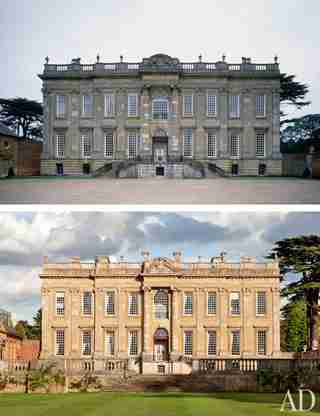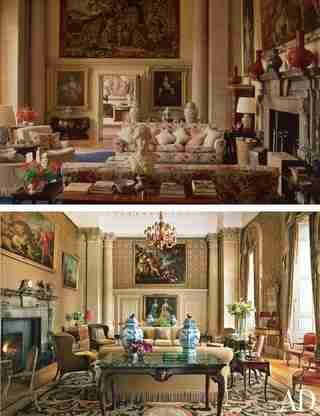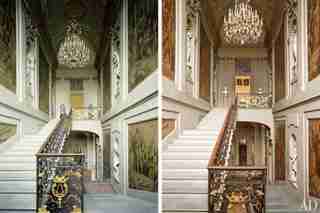
dam-images-decor-2012-05-easton-neston-renovation-easton-neston-01.jpg
Completed in 1702, Easton Neston was commissioned by Sir William Fermor and designed by renowned British architect Nicholas Hawksmoor. The Northamptonshire estate remains a splendid example of the English Baroque style—arguably the finest of its date, according to architectural historian Nikolaus Pevsner. In 2005, the third Baron Hesketh, a Fermor descendant and owner of Easton Neston when it was published in *AD’*s January 1991 issue, sold the property to Russian-born, California-based fashion mogul Leon Max, who embarked on a three-year restoration with the help of Ptolemy Dean Architects and Spencer-Churchill Designs, the results of which appeared in our May 2012 issue . Pictured: The west façade, which remains essentially unchanged since 1991 (top), is distinguished by slim windows, large Corinthian columns, and the Fermor motto— Hora e Sempre, archaic Italian for “Now and Always”—carved above the main entrance.

dam-images-decor-2012-05-easton-neston-renovation-easton-neston-02.jpg
The previous owner put generations’ worth of family possessions up for auction at Sotheby’s (bringing in more than $16 million), and Max was forced to completely furnish the house from scratch. Hawksmoor designed this room, originally called the Great Hall, with double-height ceilings, which were lowered in the 19th century to accommodate an additional floor. Although the layout and purpose of the space—formerly called the saloon, now called the drawing room—remains the same, significant decorative changes have been made. The walls are now covered in a silk damask, and the floral-pattern sofas have been replaced by more-neutral pieces.

dam-images-decor-2012-05-easton-neston-renovation-easton-neston-04.jpg
Today the Great Staircase, with its wrought-iron balustrade and early-18th-century grisaille panels by Sir James Thornhill lining the walls, looks much the same as it did when the third Baron Hesketh resided at Easton Neston. But there are subtle differences. For instance, the urns flanking the doorway at the top of the stairs have been replaced by a pair of busts, and different statues reside in the alcoves.
dam-images-decor-2012-05-easton-neston-renovation-easton-neston-03.jpg
Max converted the former drawing room—which features ornate 18th-century plasterwork and a marble mantelpiece by William Kent—into the Yellow Dining Room. The table, chandeliers, and curtain fabric were custom made for the redesigned space.
dam-images-decor-2012-05-easton-neston-renovation-easton-neston-05.jpg
Despite its name, the Tapestry Bedroom no longer showcases the bold Mortlake wall hangings it once did. The room now features a largely neutral color scheme and is furnished with a George III mahogany bed—topped by a custom-printed linen canopy—and a 19th-century Sultanabad carpet.
dam-images-decor-2012-05-easton-neston-renovation-easton-neston-06.jpg
Elements of the landscaping at Easton Neston have been updated. The lawn leading to the pool has been simplified, but the signature spiraling hedges remain.
